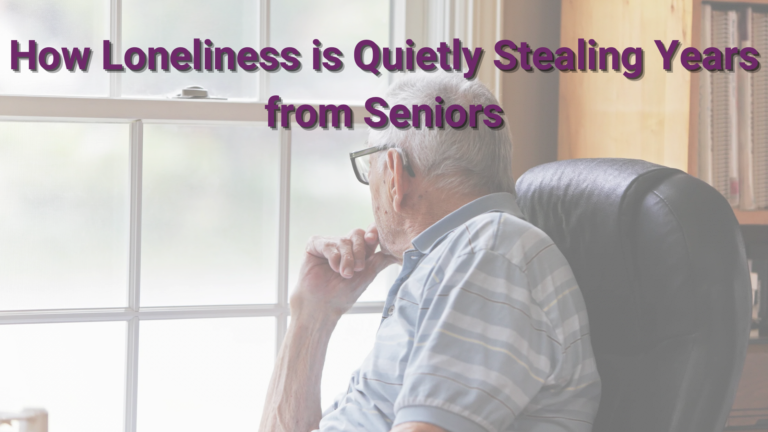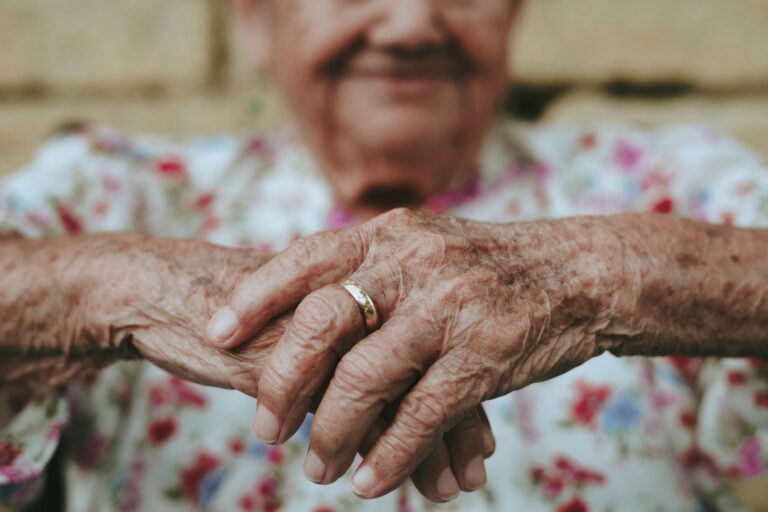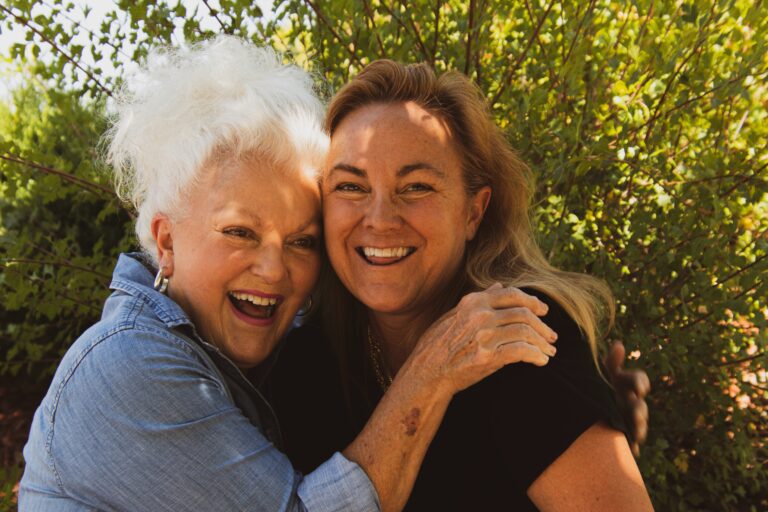Eleanor sits by her window. She watches cars pass, neighbors walk their dogs, kids rush off to school. Inside, silence. The phone doesn’t ring. The doorbell stays still. The world moves, but she feels stuck.
She used to have a full calendar. Bridge games, community bake sales, afternoons with friends. Now, the days blend together. It’s not that she wants to be alone. It’s that somewhere along the way, life got quieter.
She is not alone in feeling this way. According to an AARP study, nearly 40% of older adults report feeling lonely at times. The numbers don’t just tell a sad story. They reveal a crisis. Loneliness isn’t just a feeling. It’s a health hazard.
Why Loneliness is More Than Just Feeling Alone
Social isolation and loneliness are different. Social isolation means a person lacks regular social contact. Loneliness is the emotional experience of feeling disconnected. A person can be surrounded by people and still feel alone. A person can spend most days alone and feel content.
For many seniors, isolation turns into loneliness. Up to 43% experience social isolation. Health issues make outings harder. Friends move away. Loved ones pass. Social circles shrink.
And then something happens.
What Loneliness Does to the Body and Mind
1. Isolation Wrecks Mental Health
The human mind thrives on connection. Without it, emotional well-being deteriorates. Studies show that socially isolated seniors face a 50% higher risk of depression.
Loneliness triggers the brain’s stress response, increasing cortisol levels. Chronically high cortisol contributes to anxiety, disrupts sleep, and lowers resilience to daily stressors. Over time, the brain adapts to isolation by becoming hyper-alert to social threats, making interactions feel more difficult, which only deepens withdrawal.
According to the National Institute on Aging, persistent loneliness increases the risk of suicide in older adults, particularly men over 65. A study published in Psychological Science found that lonely individuals perceive social interactions as more stressful, leading to avoidance behaviors that worsen isolation.
When no one expects you to show up for lunch, why bother going? This mindset takes hold slowly but firmly. The result? A cycle of loneliness that becomes harder to escape.
2. Social Isolation Slows the Brain
Social interaction isn’t just pleasant—it’s essential for brain function. Research from the Journal of the American Geriatrics Society found that socially active seniors experience 70% slower rates of cognitive decline compared to their isolated peers.
The reason? Conversation forces the brain to process information, retrieve memories, and respond in real-time. This mental exercise strengthens neural pathways, much like physical exercise strengthens muscles. Without this stimulation, the brain begins to atrophy.
Loneliness has been linked to a 64% increased risk of developing dementia, according to a meta-analysis in The Lancet Healthy Longevity. Another study found that seniors with limited social engagement showed higher levels of beta-amyloid, a protein associated with Alzheimer’s disease.
MRI scans of lonely individuals reveal reduced gray matter in areas responsible for memory, decision-making, and emotional regulation. The brain quite literally shrinks when it is deprived of social interaction.
3. Social Isolation Damages the Heart
Loneliness doesn’t just make the heart ache emotionally—it weakens it physically. Research from JAMA shows that loneliness raises the risk of heart disease by 29% and stroke by 32%.
This happens because social isolation triggers a chronic inflammatory response, increasing levels of C-reactive protein (CRP) and interleukin-6, both of which contribute to arterial plaque buildup and high blood pressure.
One study found that people who report feeling lonely have higher levels of stress hormones, which elevate blood pressure and make the heart work harder. Over time, this stress damages blood vessels and increases the likelihood of heart attacks.
A report from the American Heart Association highlights that lonely individuals are less likely to adhere to medication schedules, exercise routines, or healthy eating habits, further compounding their cardiovascular risk.
4. Loneliness Can Steal Years from a Life
The health effects of loneliness are staggering. A landmark study by Dr. Julianne Holt-Lunstad found that chronic loneliness is as deadly as smoking 15 cigarettes a day.
Social isolation increases the risk of early death by 26%, a statistic confirmed by multiple studies across different populations. It contributes to weakened immune function, making the body more vulnerable to infections, chronic illnesses, and slower recovery from surgery.
Loneliness also raises the risk of obesity and Type 2 diabetes, as isolated individuals are more likely to engage in sedentary behaviors and poor eating habits. A study in Health Psychology found that lonely adults had higher levels of ghrelin, a hormone that triggers hunger, leading to increased calorie consumption and weight gain.
Perhaps the most alarming statistic comes from research published in Perspectives on Psychological Science, which found that social isolation increases all-cause mortality risk by 50%, surpassing other well-known risk factors like obesity and physical inactivity.
The impact is real. The solution? Recognizing loneliness as a critical public health issue and taking action before it robs people of their health and their years.
The Ripple Effect of Social Isolation: Families, Healthcare, and the Economy
Loneliness isn’t just a personal struggle. It radiates outward, affecting entire families, healthcare systems, and economies. The impact is financial, emotional, and social. And the cost is staggering.
Families Feel It
Social isolation doesn’t just affect the person experiencing it—it affects everyone around them.
- Adult children worry. According to AARP, 76% of adult children express concern about their aging parents being lonely. The stress of ensuring an isolated loved one’s well-being can be overwhelming, leading to emotional strain and even caregiver burnout.
- Siblings grow distant. Family bonds weaken when social isolation sets in. A survey from the National Alliance for Caregiving found that nearly 40% of family caregivers reported feeling disconnected from their siblings because they disagreed on how to support their aging parent.
- Neighbors feel helpless. Many seniors who experience isolation live alone. According to the Pew Research Center, 27% of adults over 60 live alone, a number that increases with age. While neighbors might notice signs of loneliness, they may not know how to step in.
Loneliness has a domino effect. It doesn’t just erode the health of the senior—it strains relationships, fractures support systems, and places an emotional burden on those who care.
Healthcare Pays the Price
The effects of loneliness show up in hospitals, clinics, and long-term care facilities.
- Increased doctor visits. Research from the National Institute on Aging found that socially isolated seniors have double the number of doctor visits compared to those with strong social ties.
- Longer hospital stays. Studies show that older adults who are lonely or socially isolated spend up to 50% more time hospitalized than their socially connected peers.
- Higher rates of chronic disease. The CDC reports that social isolation increases the risk of heart disease (29%), stroke (32%), and dementia (64%). These conditions drive up healthcare costs and increase the need for long-term care.
- A financial burden. The direct healthcare costs of social isolation are estimated at $6.7 billion per year in Medicare spending alone. These costs stem from preventable hospitalizations, readmissions, and emergency room visits due to unmanaged chronic conditions and mental health crises.
When loneliness turns into a health crisis, the burden falls on already strained healthcare systems. Doctors, nurses, and caregivers see the consequences firsthand—patients whose biggest ailment isn’t a medical condition, but a lack of connection.
The Fix: Simple, Powerful, and Immediate
Eleanor’s story doesn’t have to end in loneliness. The solutions exist. They are practical. They work. The key is to act now.
1. Social Hubs That Welcome Seniors
Regular, reliable social interactions are essential.
- Senior centers, support groups, and community events create spaces for older adults to engage with others on a consistent basis.
- Group activities like book clubs, game nights, and walking groups help maintain a sense of routine.
- Programs tailored to transportation needs ensure that mobility challenges don’t become barriers to connection.
Studies show that seniors who participate in group activities experience a 30% lower risk of depression and report a higher quality of life.
2. The Power of Purpose
Volunteering is a two-way street—it benefits both the giver and the receiver.
- AARP reports that seniors who volunteer have 44% lower rates of depression and are less likely to develop high blood pressure.
- Mentoring programs, charity work, and community service projects give seniors a sense of purpose and belonging.
- Helping others combats loneliness by creating a structured way to engage socially.
Purpose drives connection. And connection improves health.
3. Smart Tech, Simple Use
Technology has the power to bridge social gaps, but only if seniors feel comfortable using it.
- Video calls, online forums, and social media groups provide easy ways to stay connected with family and friends.
- Free technology classes at libraries and senior centers help older adults gain confidence in using smartphones, tablets, and computers.
- Voice-activated devices and smart assistants simplify digital interactions for those with mobility challenges.
A Pew Research study found that seniors who use the internet daily report feeling 33% less lonely than those who don’t. Digital connection is not a replacement for in-person interaction, but it is a valuable tool.
4. Bridging Generations
Intergenerational programs provide a unique way to combat isolation.
- Storytelling programs connect seniors with younger generations, fostering meaningful relationships.
- Schools and senior living communities partnering for mentorship programs help bridge the generational gap.
- Intergenerational friendships improve both mental and emotional health for seniors and young people alike.
A study from Generations United found that 93% of seniors who participated in intergenerational programs felt an increased sense of belonging.
5. A Shift in Mindset
Awareness is the first step.
- Friends, family, and neighbors must recognize loneliness as a serious issue.
- Communities must create spaces where seniors feel welcome and included.
- Every small action—a phone call, a visit, a shared meal—makes a difference.
Loneliness doesn’t disappear on its own. It takes intentional action. The good news? Connection is within reach.
Now is the Time
The crisis of loneliness doesn’t have to define aging. Eleanor’s story doesn’t have to be repeated. The solutions are simple. They are available now. They just need to be embraced.
The next time you think of an older adult in your life—whether a parent, a neighbor, or a friend—consider this: One call. One visit. One moment of real conversation.
Because when it comes to loneliness, small actions have the power to change lives.
Reach out. Make the call. Stop by for a visit. No one should feel forgotten.

From a young age, Stacey’s link to the senior care industry grew alongside her mother’s work at a nursing home, where she often accompanied her. By her early teens, she secured her first official job at a nursing home, laying the foundation for a profound journey in senior care spanning over four decades. Her roles varied from opening assisted living and memory care residences to working in nursing homes and independent senior living communities. As the former Director of Fun for 300 independent seniors, she expertly organized daily events and trips. Stacey’s unwavering passion, nurtured by her family, and professional dedication as a recreation therapist, reflect her deep commitment to preserving the dignity and well-being of seniors.
Stacey’s senior care expertise has been recognized by the media including U.S. News and World Report and Care.com.
Stacey and her husband Bryan are the owners of the senior in-home care agency A Place At Home – North Austin.




